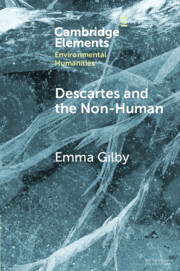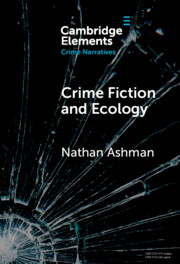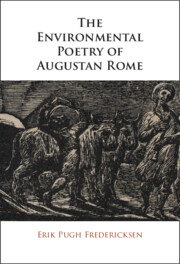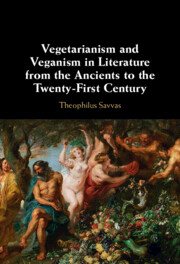Refine search
Actions for selected content:
85 results

Ruin Ecology
- An Exercise in Environmental Imagination
-
- Published online:
- 13 October 2025
- Print publication:
- 06 November 2025
-
- Element
- Export citation
Chapter 17 - The Uncertainty of Coming Times in Contemporary Irish Fiction
- from Part IV - Revivalist Futures
-
-
- Book:
- The Revival in Irish Literature and Culture
- Published online:
- 04 September 2025
- Print publication:
- 18 September 2025, pp 341-359
-
- Chapter
- Export citation
Climate Across Genre: Hyperobject Reading and Evaluating the “Use” of Climate-Fantastic Fiction
-
- Journal:
- Australian Journal of Environmental Education / Volume 41 / Issue 3 / July 2025
- Published online by Cambridge University Press:
- 08 September 2025, pp. 462-476
-
- Article
-
- You have access
- Open access
- HTML
- Export citation
13 - Joyce and Nature
-
-
- Book:
- The Cambridge Companion to James Joyce
- Published online:
- 14 August 2025
- Print publication:
- 21 August 2025, pp 216-231
-
- Chapter
- Export citation
Chapter 11 - Mary Prince’s Environmental History
-
-
- Book:
- The Cambridge Companion to Mary Prince
- Published online:
- 24 April 2025
- Print publication:
- 08 May 2025, pp 184-200
-
- Chapter
- Export citation

Descartes and the Non-Human
-
- Published online:
- 02 May 2025
- Print publication:
- 29 May 2025
-
- Element
- Export citation
Growing Grass between Concrete: A Choose-Your-Own-Adventure Game for Rewilding Literature Pedagogies
-
- Journal:
- Australian Journal of Environmental Education / Volume 41 / Issue 2 / May 2025
- Published online by Cambridge University Press:
- 31 March 2025, pp. 213-225
-
- Article
-
- You have access
- Open access
- HTML
- Export citation
Chapter 4 - Plant-Lore in the Botanical Renaissance
- from Part I - Historical Periods
-
-
- Book:
- The Cambridge Handbook of Literature and Plants
- Published online:
- 06 February 2025
- Print publication:
- 13 February 2025, pp 68-89
-
- Chapter
- Export citation
Chapter 6 - Conjuring Nineteenth-Century Black Environmentalism
-
-
- Book:
- The New Nineteenth-Century American Literary Studies
- Published online:
- 02 January 2025
- Print publication:
- 23 January 2025, pp 83-97
-
- Chapter
- Export citation
Chapter 38 - The Anthropocene
- from Part VII - Reception and Influence
-
-
- Book:
- Gerard Manley Hopkins in Context
- Published online:
- 16 January 2025
- Print publication:
- 16 January 2025, pp 326-333
-
- Chapter
- Export citation

Crime Fiction and Ecology
- From the Local to the Global
-
- Published online:
- 14 January 2025
- Print publication:
- 30 January 2025
-
- Element
- Export citation
Epilogue
-
- Book:
- The Environmental Poetry of Augustan Rome
- Published online:
- 12 December 2024
- Print publication:
- 19 December 2024, pp 258-280
-
- Chapter
- Export citation
Introduction
-
- Book:
- The Environmental Poetry of Augustan Rome
- Published online:
- 12 December 2024
- Print publication:
- 19 December 2024, pp 1-19
-
- Chapter
- Export citation

The Environmental Poetry of Augustan Rome
-
- Published online:
- 12 December 2024
- Print publication:
- 19 December 2024
8 - Clare and Ecocriticism
- from Part II - Clare the Naturalist
-
-
- Book:
- The Cambridge Companion to John Clare
- Published online:
- 14 November 2024
- Print publication:
- 21 November 2024, pp 120-134
-
- Chapter
- Export citation
Burning Hope: Staging Queer Ecology in a Time of Wildfire
-
- Journal:
- New Theatre Quarterly / Volume 40 / Issue 4 / November 2024
- Published online by Cambridge University Press:
- 10 January 2025, pp. 372-386
- Print publication:
- November 2024
-
- Article
- Export citation
47 - The Essay, Ecocriticism, and the Anthropocene
- from Part V - The Essay and the Essayistic Today
-
-
- Book:
- The Cambridge History of the British Essay
- Published online:
- 31 October 2024
- Print publication:
- 04 July 2024, pp 712-727
-
- Chapter
- Export citation
Chapter 1 - ‘everybody eating everyone else’
-
- Book:
- Vegetarianism and Veganism in Literature from the Ancients to the Twenty-First Century
- Published online:
- 30 May 2024
- Print publication:
- 06 June 2024, pp 1-19
-
- Chapter
- Export citation

Vegetarianism and Veganism in Literature from the Ancients to the Twenty-First Century
-
- Published online:
- 30 May 2024
- Print publication:
- 06 June 2024
Taxonomies of exclusion: Storytelling, naming and classification in an age of extinction
-
- Journal:
- Cambridge Prisms: Extinction / Volume 2 / 2024
- Published online by Cambridge University Press:
- 01 April 2024, e4
-
- Article
-
- You have access
- Open access
- HTML
- Export citation
